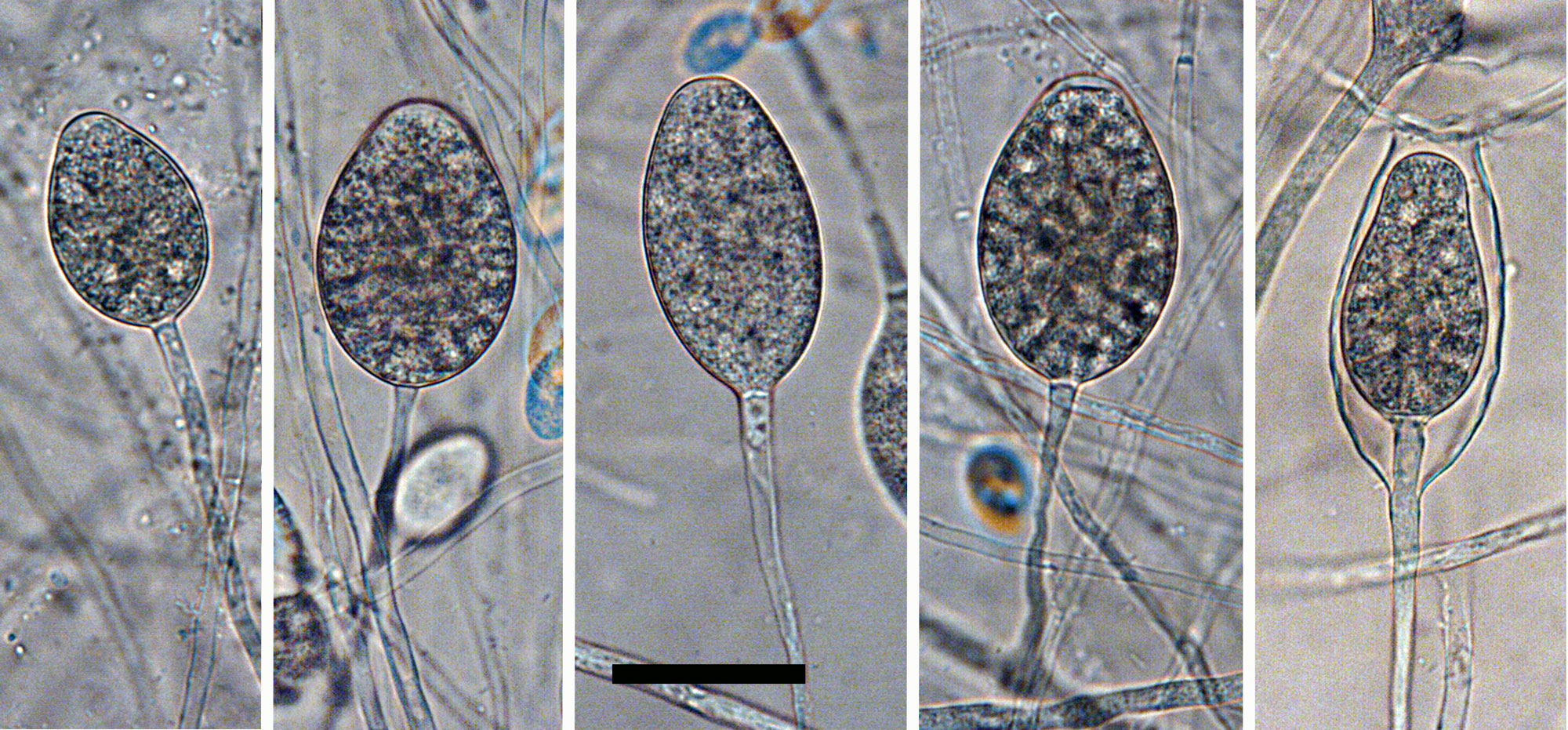Gallery
Image Type
Morphological Structure
Clades
Phytophthora spp. in Clade 2d: portion of the seven-loci ML phylogeny featuring the type cultures of 212 described species (by T. Bourret). Notice the position of P. oleae Ex-type CBS 141871 = S&T BL 219. Gloria Abad, USDA S&T.
Phytophthora spp. in Clade 2d: Morphological Tabular key (PDF) and Tabular key legends (PDF) in IDphy2 KEY SECTION. Notice the data of P. oleae Ex-type CBS 141871 = S&T BL 219. Gloria Abad, USDA S&T.
Phytophthora spp. in subclade 6a: portion of the seven-loci ML phylogeny featuring the type cultures of 212 described species (by T. Bourret). Notice the position of P. oreophila Ex-type CBS 144708. Gloria Abad, USDA S&T.
Phytophthora spp. in subclade 6a: Morphological Tabular key (PDF) and Tabular key legends (PDF) in IDphy2 KEY SECTION. Notice the data of P. oreophila Ex-type CBS 144708. Gloria Abad, USDA S&T.
 colony morphology after 5 d growth at 20ordm;C on carrot agar, V8 agar, malt extract agar, and potato-dextrose agar (from left to right)
colony morphology after 5 d growth at 20ordm;C on carrot agar, V8 agar, malt extract agar, and potato-dextrose agar (from left to right)
colony morphology after 5 d growth at 20ºC on carrot agar, V8 agar, malt extract agar, and potato-dextrose agar (from left to right)
 Oogonia with wavy walls containing aplerotic oospores, with large ooplasts which turn pale brown on maturity. Antheridia were exclusively paragynous, generally situated adjacent to the oogonial stalk; scale bar = 25micro;m.
Oogonia with wavy walls containing aplerotic oospores, with large ooplasts which turn pale brown on maturity. Antheridia were exclusively paragynous, generally situated adjacent to the oogonial stalk; scale bar = 25micro;m.
Oogonia with wavy walls containing aplerotic oospores, with large ooplasts which turn pale brown on maturity. Antheridia were exclusively paragynous, generally situated adjacent to the oogonial stalk; scale bar = 25µm.
Phytophthora spp. in subclade 6b: portion of the seven-loci ML phylogeny featuring the type cultures of 212 described species (by T. Bourret). Notice the position of P. ornamentata Ex-type CBS 140647 = S&T BL 152. Gloria Abad, USDA S&T.
Phytophthora spp. in subclade 6b: Morphological Tabular key (PDF) and Tabular key legends (PDF) in IDphy2 KEY SECTION. Notice the data of P. ornamentata Ex-type CBS 140647 = S&T BL 152. Gloria Abad, USDA S&T.
 Phytophthora ornamentata (CPHST BL 152) colonies of the ex-type grown for 7 days on (a) V8reg; Agar, (b) potato dextrose agar, and (c) malt extract agar; photo by Krysta Jennings and Leandra Knight, USDA-APHIS-PPQ
Phytophthora ornamentata (CPHST BL 152) colonies of the ex-type grown for 7 days on (a) V8reg; Agar, (b) potato dextrose agar, and (c) malt extract agar; photo by Krysta Jennings and Leandra Knight, USDA-APHIS-PPQ
Phytophthora ornamentata (CPHST BL 152) colonies of the ex-type grown for 7 days on (a) V8® Agar, (b) potato dextrose agar, and (c) malt extract agar; photo by Krysta Jennings and Leandra Knight, USDA-APHIS-PPQ
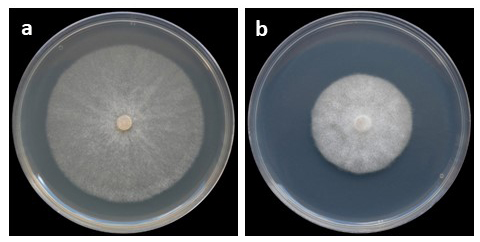 Phytophthora ornamentata colony morphology of the ex-type (PH152 ndash; Bruno Scanu) grown for 5 days at 20deg;C on (a) carrot agar, (b) potato dextrose agar; photos by Bruno Scanu and Antonio Franceschini, Universitagrave; degli Studi di Sassari, Italy
Phytophthora ornamentata colony morphology of the ex-type (PH152 ndash; Bruno Scanu) grown for 5 days at 20deg;C on (a) carrot agar, (b) potato dextrose agar; photos by Bruno Scanu and Antonio Franceschini, Universitagrave; degli Studi di Sassari, Italy
Phytophthora ornamentata colony morphology of the ex-type (PH152 – Bruno Scanu) grown for 5 days at 20°C on (a) carrot agar, (b) potato dextrose agar; photos by Bruno Scanu and Antonio Franceschini, Università degli Studi di Sassari, Italy
 Phytophthora ornamentata morphology of the ex-type (PH152 ndash; Bruno Scanu): (andash;c) asexual phase, (a) mature nonpapillate elongated persistent sporangium; (b) elongated sporangium showing internal proliferation; (c) globose to subglobose hyphal swellings with radiating hyphae; (d, e) sexual phase, ornamented oogonium, (d) with amphigynous antheridium; (e) with paragynous antheridium and finger-like projection; photos by Bruno Scanu and Antonio Franceschini
Phytophthora ornamentata morphology of the ex-type (PH152 ndash; Bruno Scanu): (andash;c) asexual phase, (a) mature nonpapillate elongated persistent sporangium; (b) elongated sporangium showing internal proliferation; (c) globose to subglobose hyphal swellings with radiating hyphae; (d, e) sexual phase, ornamented oogonium, (d) with amphigynous antheridium; (e) with paragynous antheridium and finger-like projection; photos by Bruno Scanu and Antonio Franceschini
Phytophthora ornamentata morphology of the ex-type (PH152 – Bruno Scanu): (a–c) asexual phase, (a) mature nonpapillate elongated persistent sporangium; (b) elongated sporangium showing internal proliferation; (c) globose to subglobose hyphal swellings with radiating hyphae; (d, e) sexual phase, ornamented oogonium, (d) with amphigynous antheridium; (e) with paragynous antheridium and finger-like projection; photos by Bruno Scanu and Antonio Franceschini
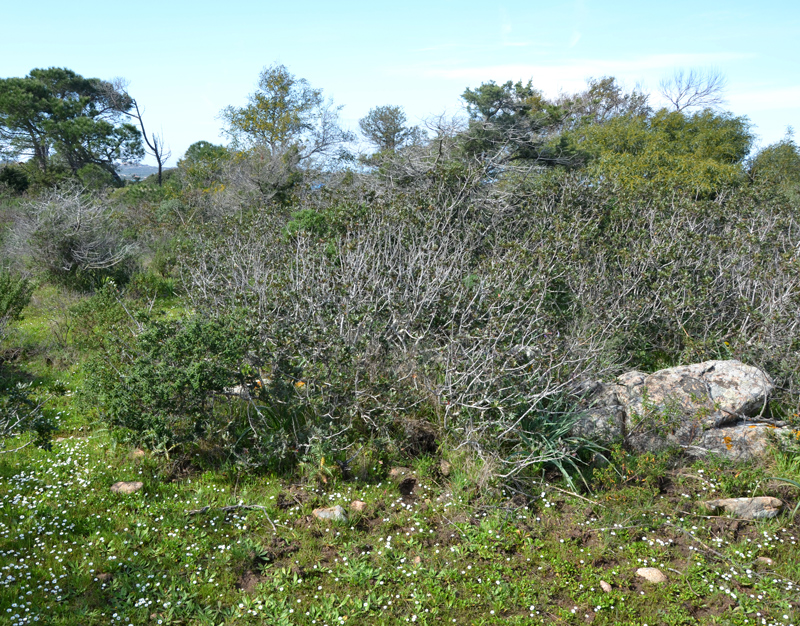 extensive dieback and mortality of Pistacia lentiscus caused by Phytophthora ornamentata in Sardinia, Italy; photo by Bruno Scanu, Universitagrave; degli Studi di Sassari, Italy
extensive dieback and mortality of Pistacia lentiscus caused by Phytophthora ornamentata in Sardinia, Italy; photo by Bruno Scanu, Universitagrave; degli Studi di Sassari, Italy
extensive dieback and mortality of Pistacia lentiscus caused by Phytophthora ornamentata in Sardinia, Italy; photo by Bruno Scanu, Università degli Studi di Sassari, Italy
Phytophthora spp. in subclade 2c: portion of the seven-loci ML phylogeny featuring the type cultures of 212 described species (by T. Bourret). Notice the position of P. pachypleura Ex-type CABI IMI502404 (AVA) = S&T BL 146. Gloria Abad, USDA S&T.
Phytophthora spp. in subclade 2c: Morphological Tabular key (PDF) and Tabular key legends (PDF) in IDphy2 KEY SECTION. Notice the data of P. pachypleura Ex-type CABI IMI502404 (AVA) = S&T BL 146. Gloria Abad, USDA S&T.
 Phytophthora pachypleura (CPHST BL 146) colonies of the ex-type grown for 7 days on (a) V8reg; Agar, (b) potato dextrose agar, and (c) malt extract agar; photo by Krysta Jennings and Leandra Knight, USDA-APHIS-PPQ
Phytophthora pachypleura (CPHST BL 146) colonies of the ex-type grown for 7 days on (a) V8reg; Agar, (b) potato dextrose agar, and (c) malt extract agar; photo by Krysta Jennings and Leandra Knight, USDA-APHIS-PPQ
Phytophthora pachypleura (CPHST BL 146) colonies of the ex-type grown for 7 days on (a) V8® Agar, (b) potato dextrose agar, and (c) malt extract agar; photo by Krysta Jennings and Leandra Knight, USDA-APHIS-PPQ
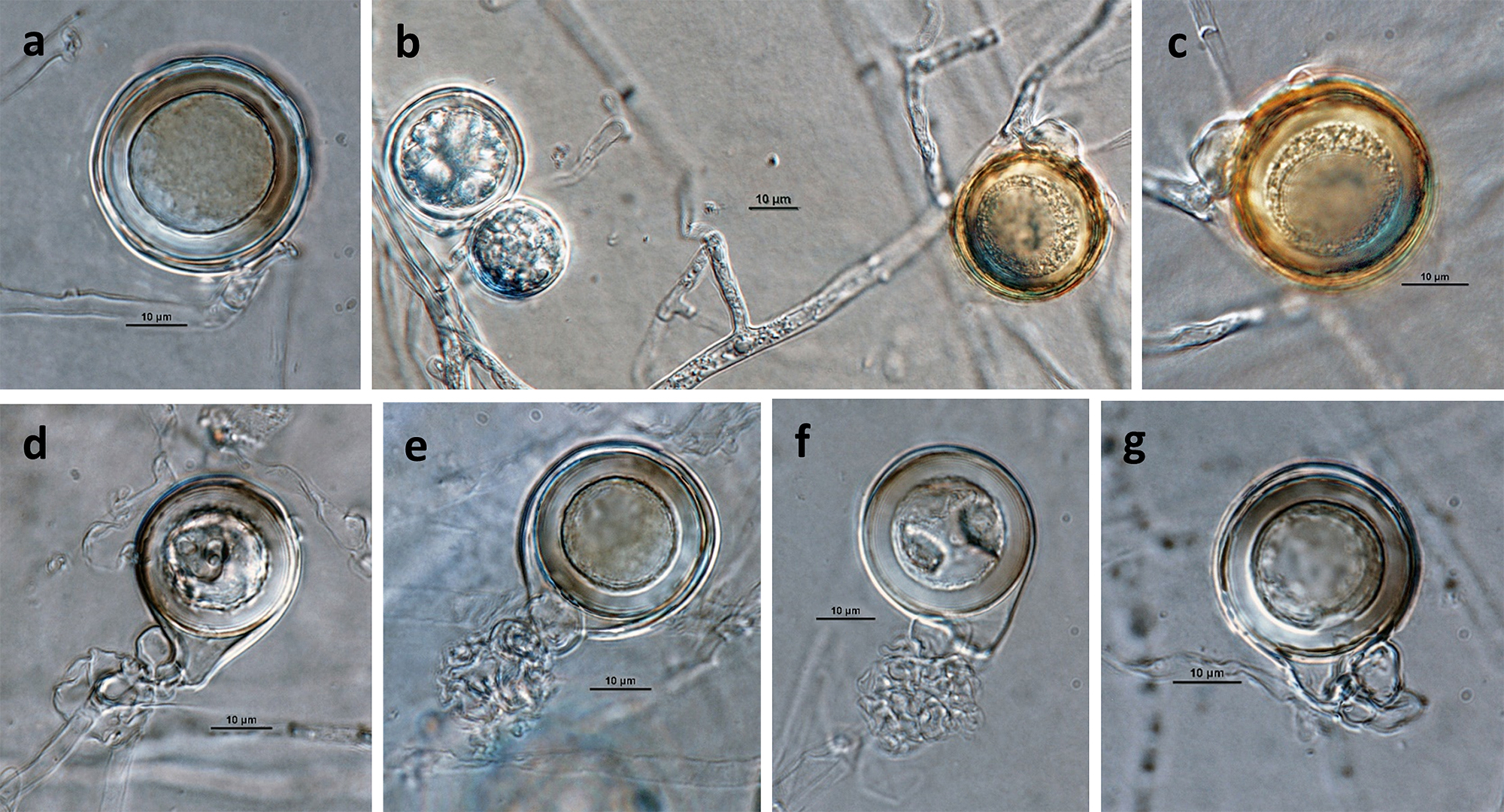 Phytophthora pachypleura (ex-type CPHST BL 146) sexual phase: (andash;c) gold-brown oogonia with paragynous antheridia and plerotic oospores, (dndash;g) oogonia with tapered bases and paragynous antheridia; photos by Gloria Abad, USDA-APHIS-PPQ.
Phytophthora pachypleura (ex-type CPHST BL 146) sexual phase: (andash;c) gold-brown oogonia with paragynous antheridia and plerotic oospores, (dndash;g) oogonia with tapered bases and paragynous antheridia; photos by Gloria Abad, USDA-APHIS-PPQ.
Phytophthora pachypleura (ex-type CPHST BL 146) sexual phase: (a–c) gold-brown oogonia with paragynous antheridia and plerotic oospores, (d–g) oogonia with tapered bases and paragynous antheridia; photos by Gloria Abad, USDA-APHIS-PPQ.
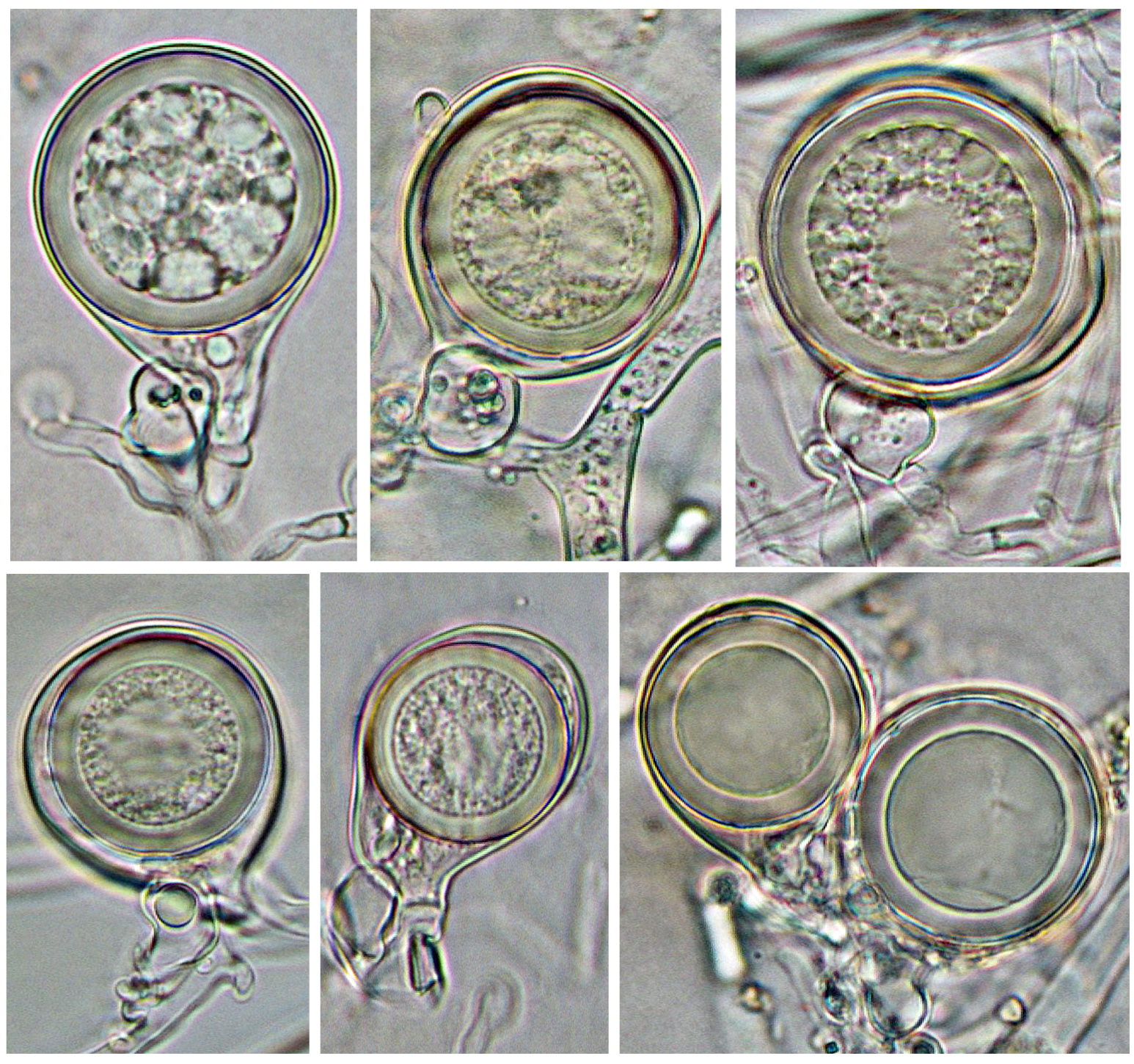 Phytophthora pachypleura (ex-type, 1 BH-2013 strain RHS 53593.1) homothallic sexual phase: smooth-walled oogonia, with paragynous antheridia, sometimes with tapered bases. Oospores can be plerotic or aplerotic; photo by Beatrice Henricot, The Royal Horticultural Society.
Phytophthora pachypleura (ex-type, 1 BH-2013 strain RHS 53593.1) homothallic sexual phase: smooth-walled oogonia, with paragynous antheridia, sometimes with tapered bases. Oospores can be plerotic or aplerotic; photo by Beatrice Henricot, The Royal Horticultural Society.
Phytophthora pachypleura (ex-type, 1 BH-2013 strain RHS 53593.1) homothallic sexual phase: smooth-walled oogonia, with paragynous antheridia, sometimes with tapered bases. Oospores can be plerotic or aplerotic; photo by Beatrice Henricot, The Royal Horticultural Society.
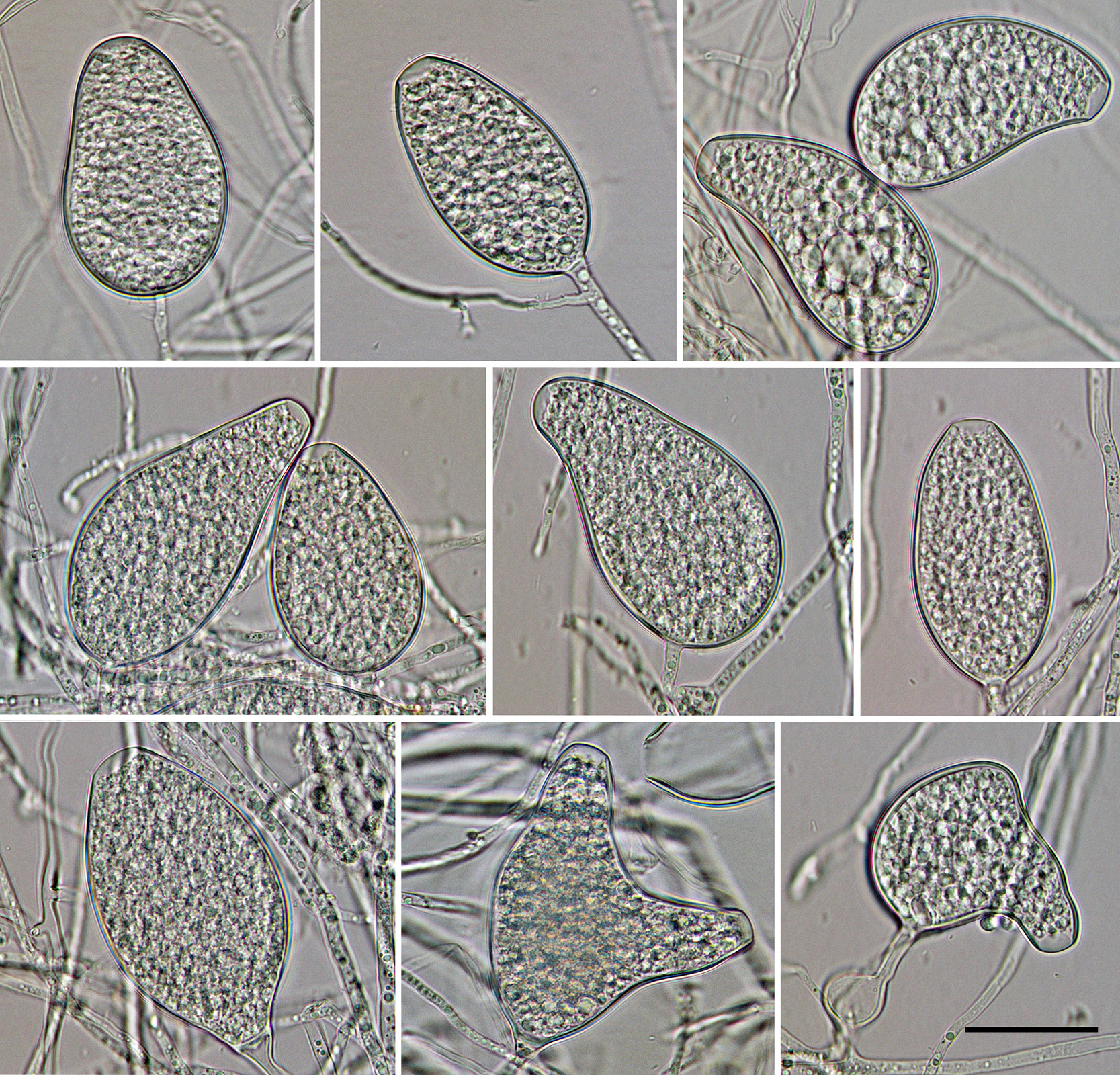 Phytophthora pachypleura (ex-type, 1 BH-2013 strain RHS 53593.1) asexual phase: semipapillate, sometimes bipapillate, persistent sporangia with distorted shapes and hyphal swellings in sporangiophores; photos by Beatrice Henricot, The Royal Horticultural Society.
Phytophthora pachypleura (ex-type, 1 BH-2013 strain RHS 53593.1) asexual phase: semipapillate, sometimes bipapillate, persistent sporangia with distorted shapes and hyphal swellings in sporangiophores; photos by Beatrice Henricot, The Royal Horticultural Society.
Phytophthora pachypleura (ex-type, 1 BH-2013 strain RHS 53593.1) asexual phase: semipapillate, sometimes bipapillate, persistent sporangia with distorted shapes and hyphal swellings in sporangiophores; photos by Beatrice Henricot, The Royal Horticultural Society.
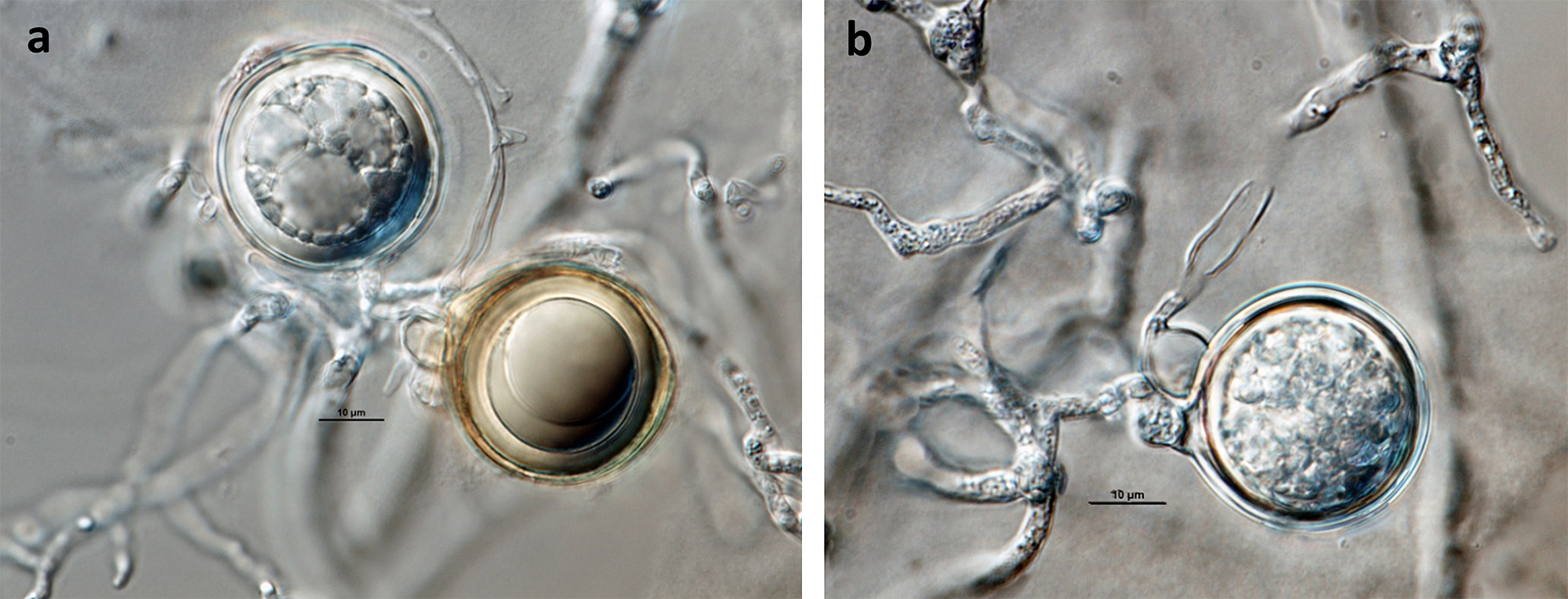 Phytophthora pachypleura nbsp;(ex-type CPHST BL 146) sexual phase: (a) gold-brown oogonium with paragynous antheridia and plerotic oospore with ooplast, and young oogonium, (b) aplerotic oospore in smooth-walled oogonium with paragynous diclinous antheridium; photos by Gloria Abad, USDA-APHIS-PPQ.
Phytophthora pachypleura nbsp;(ex-type CPHST BL 146) sexual phase: (a) gold-brown oogonium with paragynous antheridia and plerotic oospore with ooplast, and young oogonium, (b) aplerotic oospore in smooth-walled oogonium with paragynous diclinous antheridium; photos by Gloria Abad, USDA-APHIS-PPQ.
Phytophthora pachypleura (ex-type CPHST BL 146) sexual phase: (a) gold-brown oogonium with paragynous antheridia and plerotic oospore with ooplast, and young oogonium, (b) aplerotic oospore in smooth-walled oogonium with paragynous diclinous antheridium; photos by Gloria Abad, USDA-APHIS-PPQ.
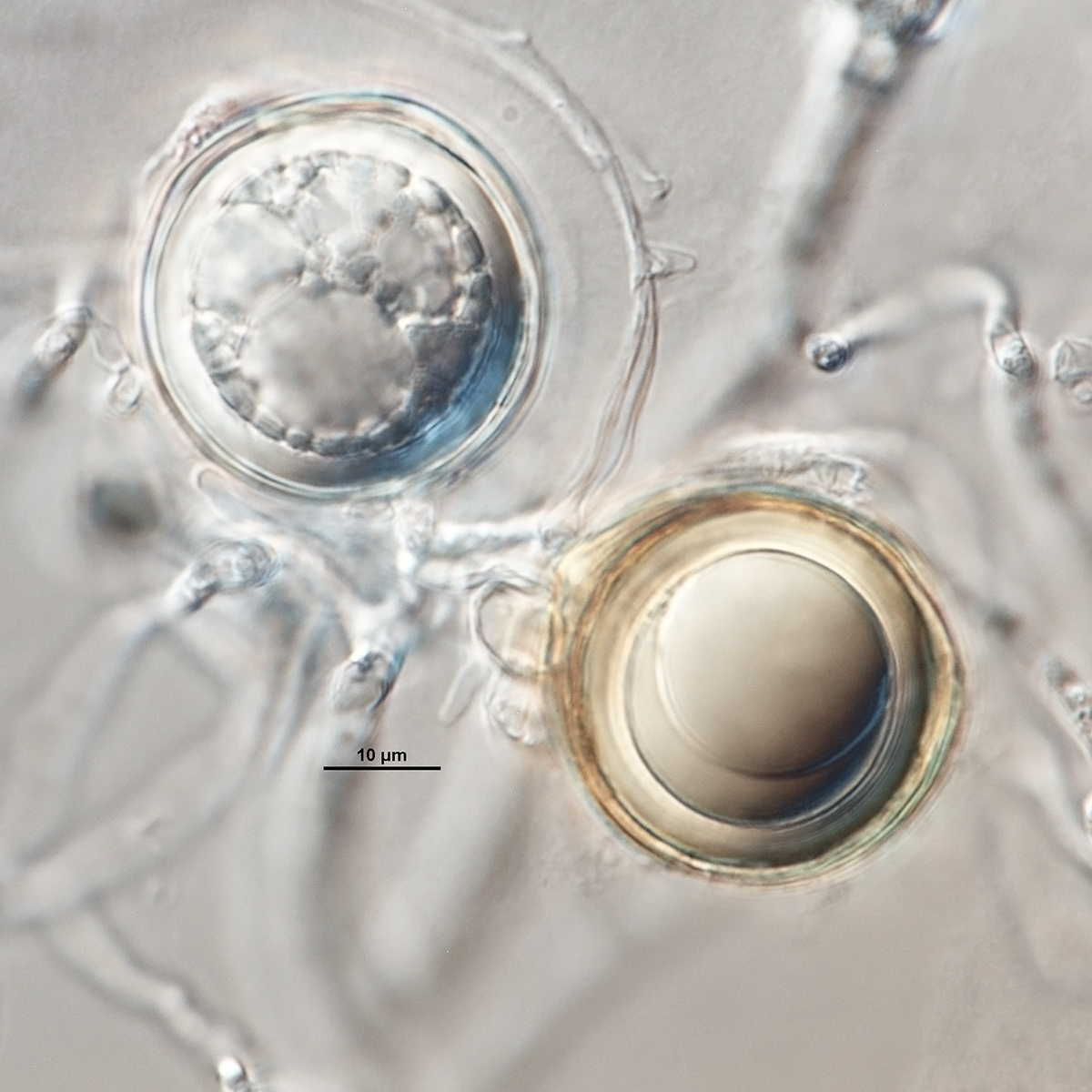 Phytophthora pachypleura nbsp;(ex-type CPHST BL 146) sexual phase:nbsp;gold-brown oogonium with paragynous antheridia and plerotic oospore with ooplast, and young oogonium; photonbsp;by Gloria Abad, USDA-APHIS-PPQ.
Phytophthora pachypleura nbsp;(ex-type CPHST BL 146) sexual phase:nbsp;gold-brown oogonium with paragynous antheridia and plerotic oospore with ooplast, and young oogonium; photonbsp;by Gloria Abad, USDA-APHIS-PPQ.
Phytophthora pachypleura (ex-type CPHST BL 146) sexual phase: gold-brown oogonium with paragynous antheridia and plerotic oospore with ooplast, and young oogonium; photo by Gloria Abad, USDA-APHIS-PPQ.
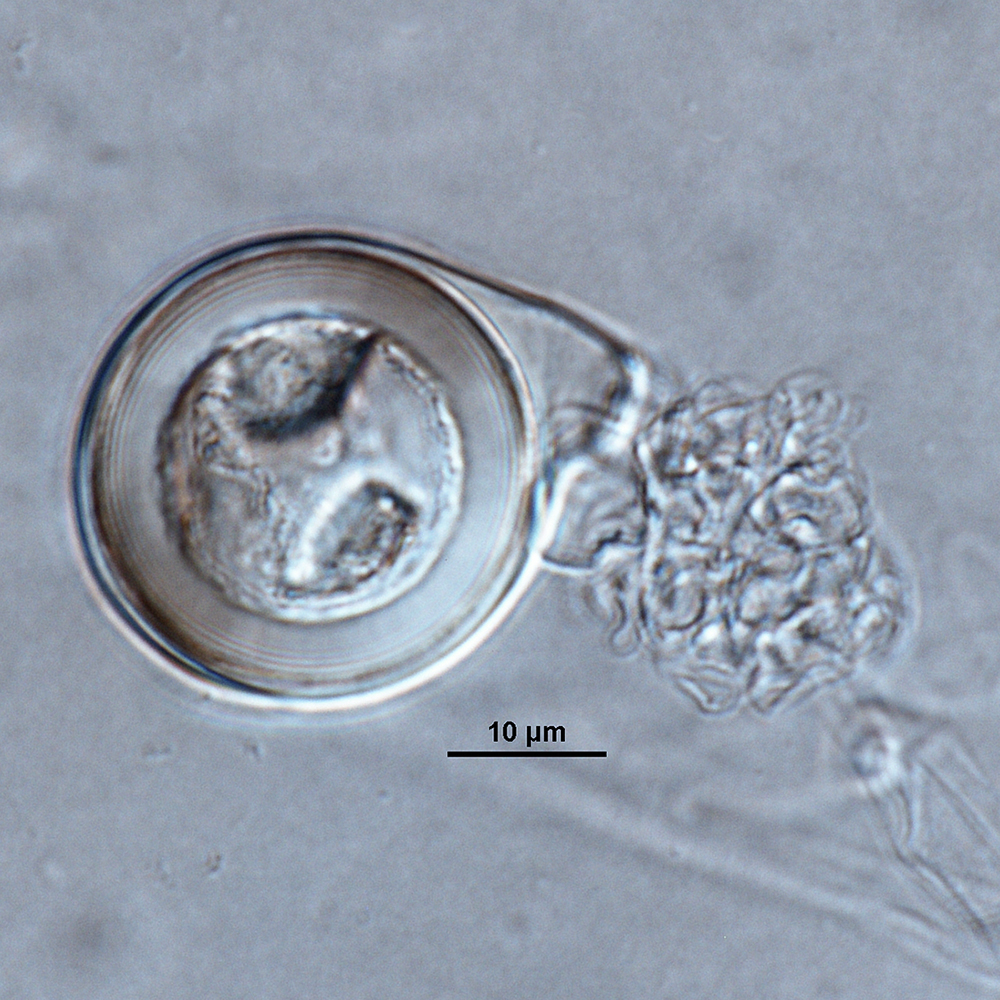 Phytophthora pachypleura (ex-type CPHST BL 146) sexual phase: oogonium with tapered base and paragynous antheridium; photo by Gloria Abad, USDA-APHIS-PPQ.
Phytophthora pachypleura (ex-type CPHST BL 146) sexual phase: oogonium with tapered base and paragynous antheridium; photo by Gloria Abad, USDA-APHIS-PPQ.
Phytophthora pachypleura (ex-type CPHST BL 146) sexual phase: oogonium with tapered base and paragynous antheridium; photo by Gloria Abad, USDA-APHIS-PPQ.
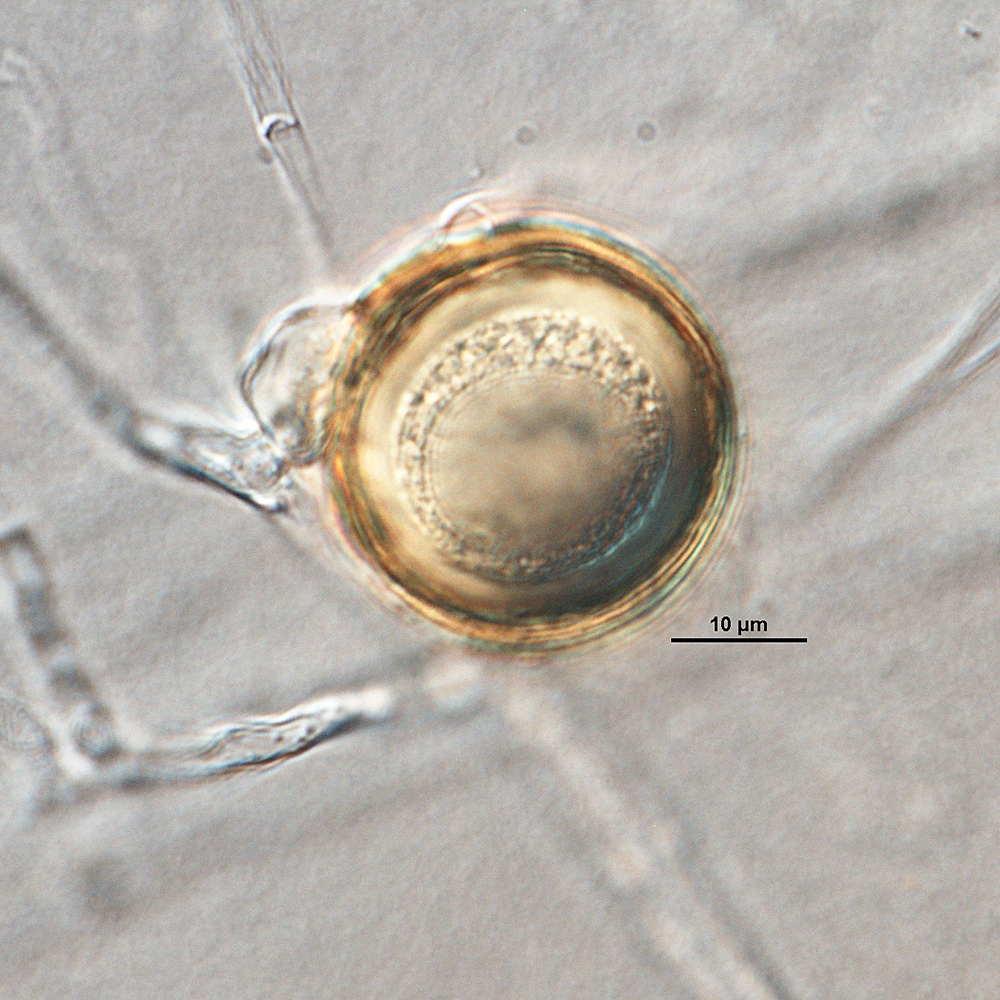 Phytophthora pachypleuranbsp; (ex-type CPHST BL 146) sexual phase: gold-brown oogoniumnbsp;with paragynous antheridiumnbsp;and plerotic oospore; photonbsp;by Gloria Abad, USDA-APHIS-PPQ.
Phytophthora pachypleuranbsp; (ex-type CPHST BL 146) sexual phase: gold-brown oogoniumnbsp;with paragynous antheridiumnbsp;and plerotic oospore; photonbsp;by Gloria Abad, USDA-APHIS-PPQ.
Phytophthora pachypleura (ex-type CPHST BL 146) sexual phase: gold-brown oogonium with paragynous antheridium and plerotic oospore; photo by Gloria Abad, USDA-APHIS-PPQ.
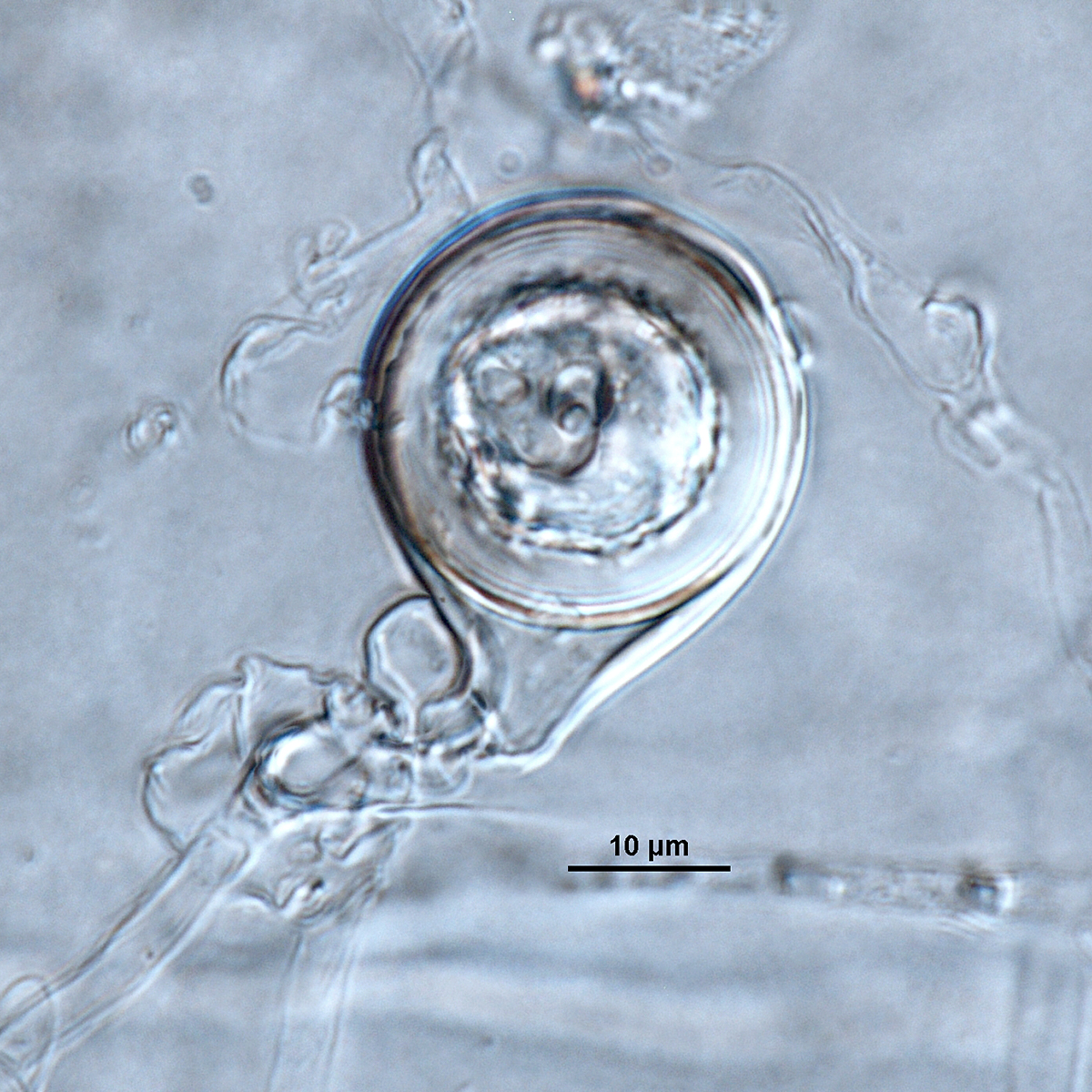 Phytophthora pachypleura (ex-type CPHST BL 146) sexual phase: oogonium with tapered base and paragynous antheridium; photo by Gloria Abad, USDA-APHIS-PPQ.
Phytophthora pachypleura (ex-type CPHST BL 146) sexual phase: oogonium with tapered base and paragynous antheridium; photo by Gloria Abad, USDA-APHIS-PPQ.
Phytophthora pachypleura (ex-type CPHST BL 146) sexual phase: oogonium with tapered base and paragynous antheridium; photo by Gloria Abad, USDA-APHIS-PPQ.
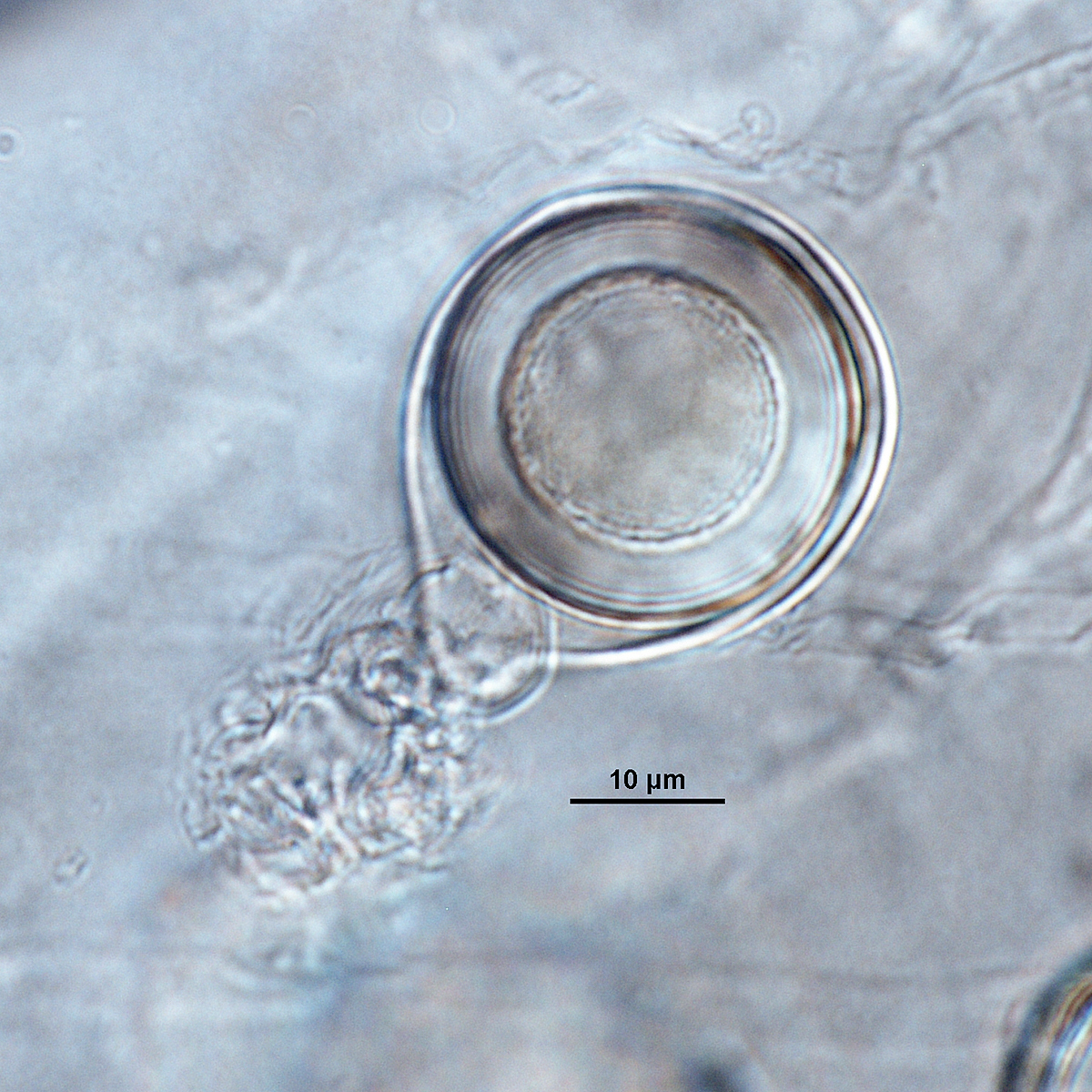 Phytophthora pachypleura (ex-type CPHST BL 146) sexual phase: oogonium with tapered base and paragynous antheridium; photo by Gloria Abad, USDA-APHIS-PPQ.
Phytophthora pachypleura (ex-type CPHST BL 146) sexual phase: oogonium with tapered base and paragynous antheridium; photo by Gloria Abad, USDA-APHIS-PPQ.
Phytophthora pachypleura (ex-type CPHST BL 146) sexual phase: oogonium with tapered base and paragynous antheridium; photo by Gloria Abad, USDA-APHIS-PPQ.
 Phytophthora pachypleura (ex-type CPHST BL 146) sexual phase: oogonium with tapered base and paragynous antheridium; photo by Gloria Abad, USDA-APHIS-PPQ.
Phytophthora pachypleura (ex-type CPHST BL 146) sexual phase: oogonium with tapered base and paragynous antheridium; photo by Gloria Abad, USDA-APHIS-PPQ.
Phytophthora pachypleura (ex-type CPHST BL 146) sexual phase: oogonium with tapered base and paragynous antheridium; photo by Gloria Abad, USDA-APHIS-PPQ.
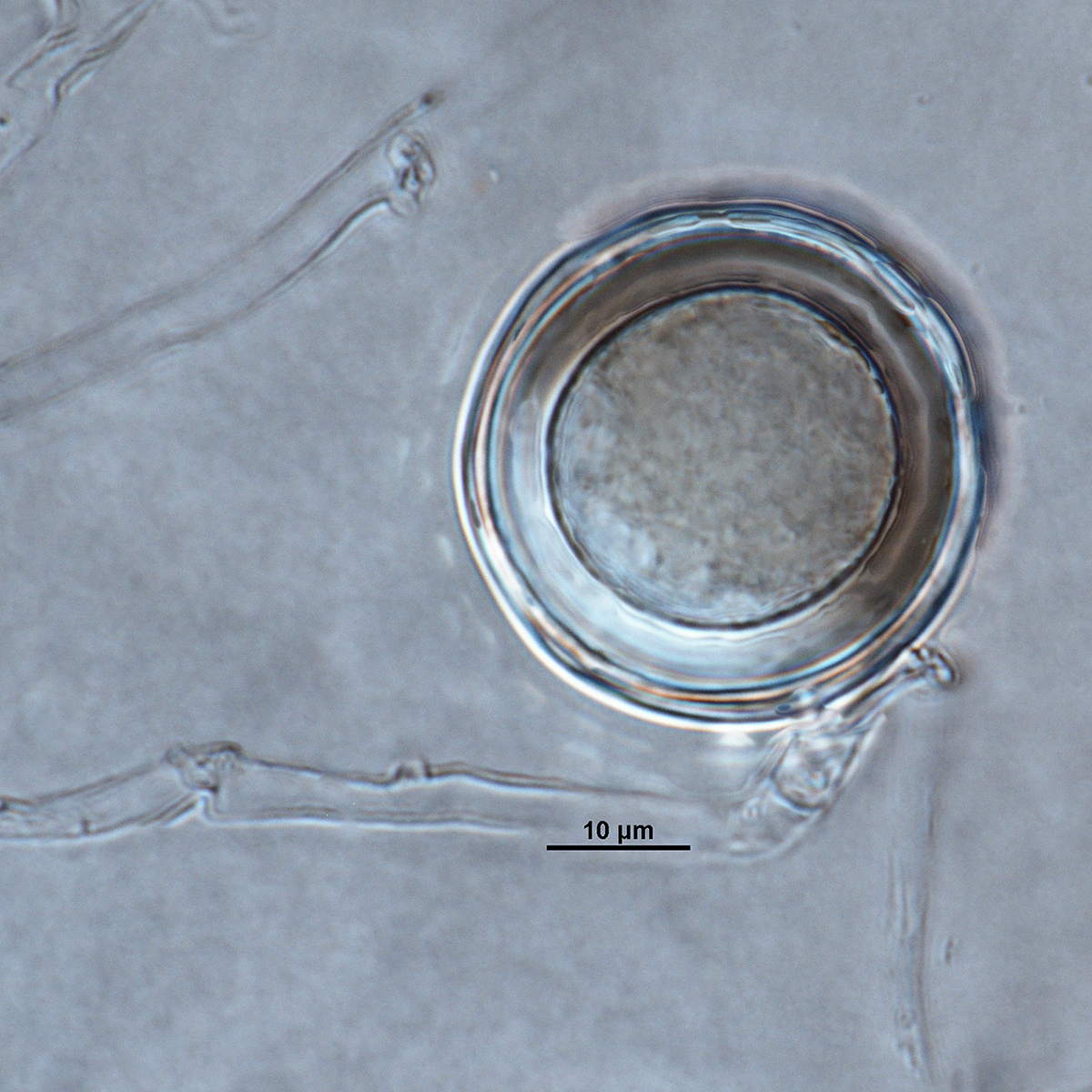 Phytophthora pachypleuranbsp; (ex-type CPHST BL 146) sexual phase:nbsp;oogoniumnbsp;with paragynous antheridiumnbsp;and plerotic oospore; photonbsp;by Gloria Abad, USDA-APHIS-PPQ.
Phytophthora pachypleuranbsp; (ex-type CPHST BL 146) sexual phase:nbsp;oogoniumnbsp;with paragynous antheridiumnbsp;and plerotic oospore; photonbsp;by Gloria Abad, USDA-APHIS-PPQ.
Phytophthora pachypleura (ex-type CPHST BL 146) sexual phase: oogonium with paragynous antheridium and plerotic oospore; photo by Gloria Abad, USDA-APHIS-PPQ.
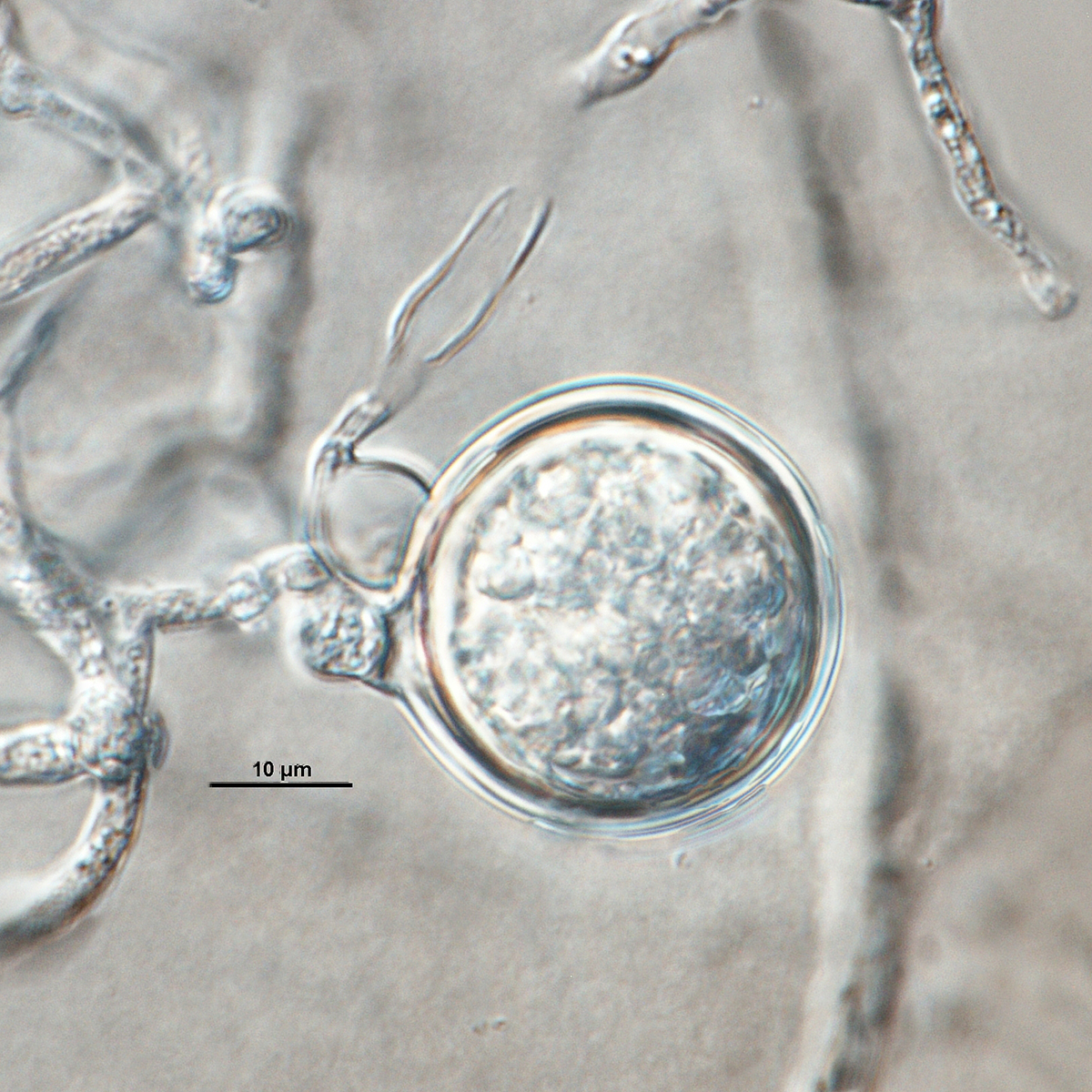 Phytophthora pachypleura nbsp;(ex-type CPHST BL 146) sexual phase: aplerotic oospore in smooth-walled oogonium with paragynous diclinous antheridium; photonbsp;by Gloria Abad, USDA-APHIS-PPQ.
Phytophthora pachypleura nbsp;(ex-type CPHST BL 146) sexual phase: aplerotic oospore in smooth-walled oogonium with paragynous diclinous antheridium; photonbsp;by Gloria Abad, USDA-APHIS-PPQ.
Phytophthora pachypleura (ex-type CPHST BL 146) sexual phase: aplerotic oospore in smooth-walled oogonium with paragynous diclinous antheridium; photo by Gloria Abad, USDA-APHIS-PPQ.
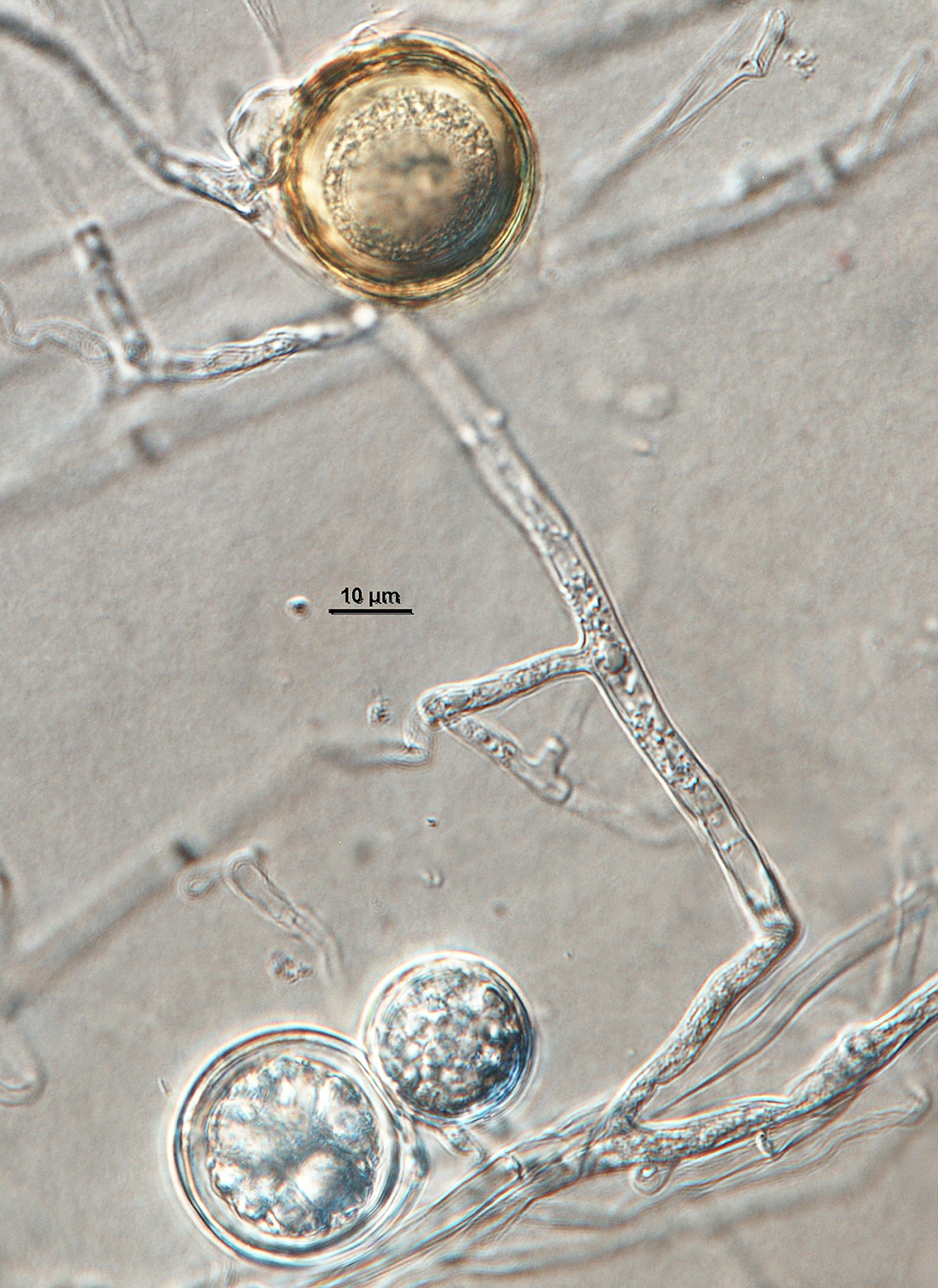 Phytophthora pachypleuranbsp; (ex-type CPHST BL 146) sexual phase:nbsp;gold-brown oogonia with paragynous antheridia and plerotic oospores; photonbsp;by Gloria Abad, USDA-APHIS-PPQ.
Phytophthora pachypleuranbsp; (ex-type CPHST BL 146) sexual phase:nbsp;gold-brown oogonia with paragynous antheridia and plerotic oospores; photonbsp;by Gloria Abad, USDA-APHIS-PPQ.
Phytophthora pachypleura (ex-type CPHST BL 146) sexual phase: gold-brown oogonia with paragynous antheridia and plerotic oospores; photo by Gloria Abad, USDA-APHIS-PPQ.
Phytophthora spp. in Clade 4: portion of the seven-loci ML phylogeny featuring the type cultures of 212 described species (by T. Bourret). Notice the position of P. palmivora selected specimen CBS 305.62 = S&T BL 105. Gloria Abad, USDA S&T.
Phytophthora spp. in Clade 4: Morphological Tabular key (PDF) and Tabular key legends (PDF) in IDphy2 KEY SECTION. Notice the data of P. palmivora selected specimen CBS 305.62 = S&T BL 105. Gloria Abad, USDA S&T.
 Phytophthora palmivora (CPHST BL 105) colonies of the selected specimen #1 grown for 7 days on (a) V8reg; Agar, (b) potato dextrose agar, and (c) malt extract agar; photo by Krysta Jennings and Leandra Knight, USDA-APHIS-PPQ
Phytophthora palmivora (CPHST BL 105) colonies of the selected specimen #1 grown for 7 days on (a) V8reg; Agar, (b) potato dextrose agar, and (c) malt extract agar; photo by Krysta Jennings and Leandra Knight, USDA-APHIS-PPQ
Phytophthora palmivora (CPHST BL 105) colonies of the selected specimen #1 grown for 7 days on (a) V8® Agar, (b) potato dextrose agar, and (c) malt extract agar; photo by Krysta Jennings and Leandra Knight, USDA-APHIS-PPQ

